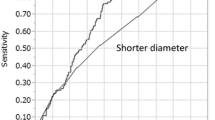Abstract
The purpose of this study was to clarify the normal gastric FDG uptake pattern to provide basic information to make an accurate diagnosis of gastric lesions by FDG PET.
We examined 22 cases, including 9 of malignant lymphoma, 8 of lung cancer, 2 of esophageal cancer, and 3 of other malignancies. No gastric lesions were observed in any of the 22 cases on upper gastrointestinal examinations using either barium meal or endoscopic techniques. The intervals between FDG PET and the gastrointestinal examination were within one week in all cases. The stomach regions were classified into the following three areas: U (upper)-area, M (middle)-area, and L (lower)-area. The degree of FDG uptake in these three gastric regions was qualitatively evaluated by visual grading into 4 degrees, and then a semiquantitative evaluation was carried out using the standardized uptake value (SUV).
Based on a visual grading evaluation, the mean FDG uptake score in the U-, M-, and L-areas was 1.14 ± 0.96, 0.82 ± 0.96, and 0.36 ± 0.49 (mean ± S.D.), respectively. The FDG uptake scores obtained in the three areas were significantly different (Friedman test, p < 0.05). Furthermore, the rank order of the FDG uptake score in each case (U ≥ M ≥ L) was found to be statistically significant (Cochran-Armitage trend test, p < 0.05). The mean SUVs of 11 cases in the three areas were 2.38 ± 1.03, 1.91 ± 0.71, and 1.34 ± 0.44 (mean ± S.D.), respectively. The SUV in the U-area was significantly higher than that in the L-area (Friedman test, p < 0.05). A significant difference in FDG uptake was observed among the three gastric areas, and the FDG uptake extent in all cases was U > M > L. In conclusion, the physiological gastric FDG uptake was significantly higher at the oral end. A stronger gastric FDG uptake at the anal end may therefore be suggestive of a pathological uptake.
Similar content being viewed by others
References
Cook GJ, Fogelman I, Maisey MN. Normal physiological and benign pathological variants of 18-fluoro-2-deoxy-glucose positron-emission tomography scanning: potential for error in interpretation.Semin Nucl Med 1996; 26:308- 314.
Kato T, Tsukamoto E, Suginami Y, Mabuchi M, Yoshinaga K, Takano A, et al. Visualization of normal organs in whole-body FDG-PET imaging.KAKU IGAKU (Jpn J Nucl Med) 1999; 36:971–977. [in Japanese]
Gordon BA, Flanagan FL, Dehdashti F. Whole-body positron emission tomography: Normal variations, pitfalls, and technical considerations.AJR 1997:169; 1675–1680.
Oku S, Nakagawa K, Momose T, Kumakura Y, Abe A, Watanabe T, et al. FDG-PET after radiotherapy is a good prognostic indicator of rectal cancer.Ann Nucl Med 2002; 16:409–416.
Whiteford MH, Whiteford HM, Yee LF, Ogunbiyi OA, Dehdashti F, Siegel BA, et al. Usefulness of FDG-PET scan in the assessment of suspected metastatic or recurrent adenocarcinoma of the colon and rectum.Dis Colon Rectum 2000; 43:759–767.
Keogan MT, Lowe VJ, Baker ME, McDermott VG, Lyerly HK, Coleman RE. Local recurrence of rectal cancer: evaluation with F-18 fluorodeoxyglucose PET imaging.Abdom Imaging 1997; 22:332–337.
Shreve PD, Anzai Y, Wahl RL. Pitfalls in oncologic diagnosis with FDG PET Imaging: physiologic and benign variants.Radiographics 1999:19; 61–77.
Nunez RF, Yeung HW, Macapinlac H. Increased F-18 FDG uptake in the stomach.Clin Nucl Med 1999; 24:281–282.
De Potter T, Flamen P, Van Cutsem E, Penninckx F, Filez L, Bormans G, et al. Whole-body PET with FDG for the diagnosis of recurrent gastric cancer.Eur J Nucl Med Mol Imaging 2002; 29:525–529.
Rodriguez M, Ahlstrom H, Sundin A, Rehn S, Sundstrom C, Hagberg H, et al. [I8F] FDG PET in gastric non-Hodgkin’s lymphoma.Acta Oncol 1997; 36:577–584.
Kato T, Komatsu Y, Tsukamoto E, Takei M, Takei T, Yamamoto F, et al. Intense F-18 FDG accumulation in the stomach in a patient with Menetrier’s disease.Clin Nucl Med 2002; 27:376–377.
The Japan Gastric Cancer Society.General rules of for clinical and pathological records of gastric cancer. Tokyo; Kanahara, 1999. [in Japanese]
Fawcett DW. The esophagus and stomach. In:A Textbook of Histology. Fawcett DW (ed), twelfth ed., New York; Chapman & Hall, 1994: 593–613.
Karantanas AH, Tsianos EB, Kontogiannis DS, Pappas IC, Katsiotis PA. CT demonstration of normal gastric wall thickness: The value of administering gas-producing and paralytic agent.Comput Med Imaging Graph 1988; 12:333–337.
Gary H, Bannister LH, Berry MM, Collins P, Dyson M, Dussek JE, et al. Alimentary system. In:Gray’s anatomy. Williams PL (ed), thirty-eighth ed., New York; Churchill Livingstone Inc., 1995: 1683–1812.
Barrington SF, Maisey MN. Skeletal muscle uptake of Fluorine-18-FDG: Effect of oral diazepam.J Nucl Med 1996:37; 1127–1129.
Sasaki M, Kuwabara Y, Yoshida T, Nakagawa M, Koga H, Hayashi K, et al. Comparison of MET-PET and FDG-PET for differentiation between benign lesions and malignant tumors of the lung.Ann Nucl Med 2001 ; 15:425–431.
Hain SF, Curran KM, Beggs AD, Fogelman I, O’Doherty MJ, Maisey MN, et al. FDG-PET as a “metabolic biopsy” tool in thoracic lesions with indeterminate biopsy.Eur J Nucl Med 2001; 28:1336–1340.
Ho CL, Dehdashti F, Griffeth LK, Buse PE, Balfe DM, Siegel BA. FDG-PET evaluation of indeterminate pancreatic masses.J Comput Assist Tomogr 1996; 20:363–369.
Stahl A, Ott K, Weber WA, Becker K, Link T, Siewert JR, et al. FDG-PET imaging of locally advanced gastric carcinomas: correlation with endoscopic and histopathological findings.Eur J Nucl Med Mol Imaging 2002; 30:288–295.
Author information
Authors and Affiliations
Corresponding author
Rights and permissions
About this article
Cite this article
Koga, H., Sasaki, M., Kuwabara, Y. et al. An analysis of the physiological FDG uptake pattern in the stomach. Ann Nucl Med 17, 733–738 (2003). https://doi.org/10.1007/BF02984984
Received:
Accepted:
Issue Date:
DOI: https://doi.org/10.1007/BF02984984




